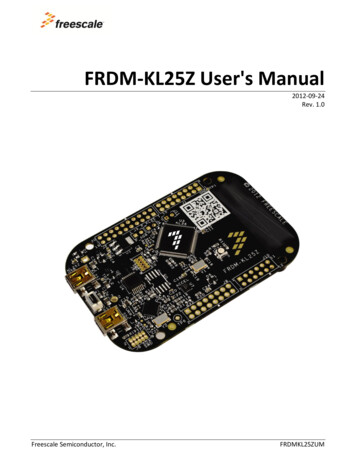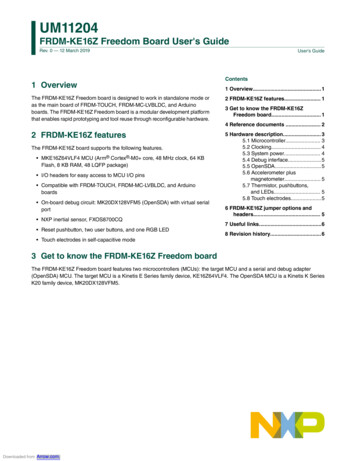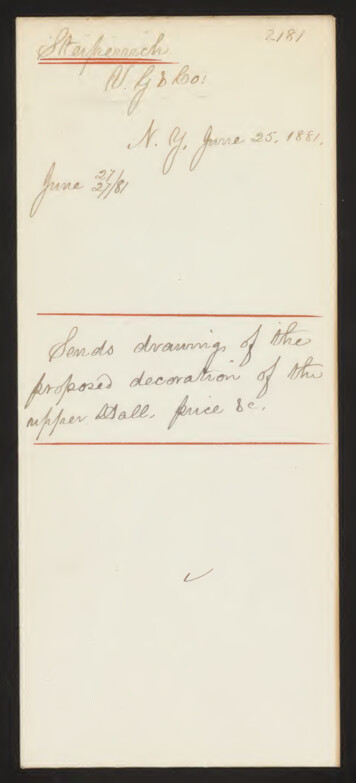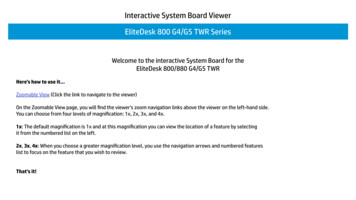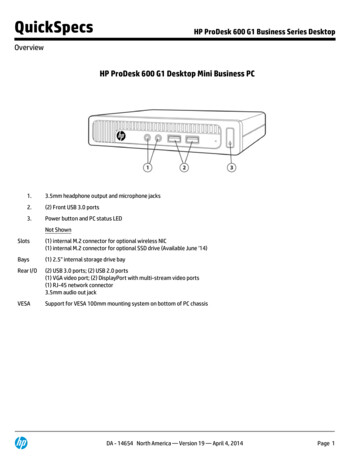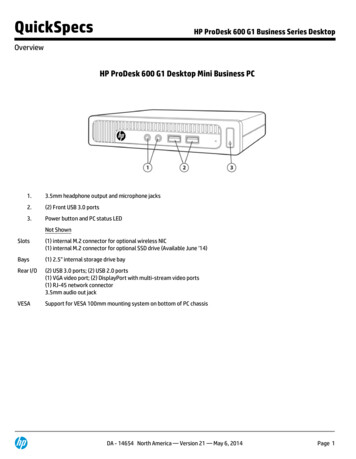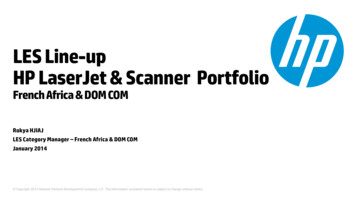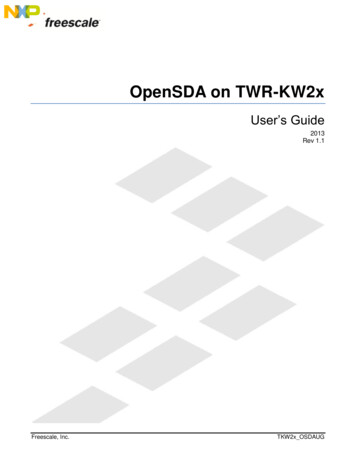
Transcription
OpenSDA on TWR-KW2xUser’s Guide2013Rev 1.1Freescale, Inc.TKW2x OSDAUG
Table of Contents1 Overview .31.1 OpenSDA Hardware .41.2 OpenSDA Software.41.2.1 MSD Bootloader .41.2.2 P&E Debug Application.51.2.3 MSD Flash Programmer .61.2.4 USB Communications Device Class (CDC) .72 Getting Started with OpenSDA .82.1 Getting into Bootloader Mode .82.2 Loading an OpenSDA Application .82.3 Using the MSD Flash Programmer .83 LED Status Indicator .9TKW2x OSDAUGOpenSDA User’s Guide2
1OverviewOpenSDA is an open-standard serial and debug adapter. It bridges serial and debug communicationsbetween a USB host and an embedded target processor as shown in Figure 1. The hardware circuit isbased on a Freescale Kinetis K20 family microcontroller (MCU) with 128 KB of embedded flash and anintegrated USB controller.The host interface supports two application modes:- Mass Storage Device (MSD): Allows to easily program applications into the flash of the targetprocessor by dragging the new binary onto the drive- Debug Application: Provides an interface to Integrated Development Environment (IDE) software,allowing the debug of an application directly from the OpenSDA interface.Both application modes support the USB Communications Device Class (USB CDC Interface) thatbridges serial communications between the USB Host and a UART serial interface on the targetprocessor.In order to switch between these application modes, the OpenSDA interface processor must be startedin bootloader mode and the corresponding OpenSDA application firmware has to be dragged anddropped into the drive.Note: Previous OpenSDA firmware didn’t incorporate both MSD and Debug applications into the samefirmware. Current version supports both functionalities in the same firmware.This document provides information required to operate OpenSDA. Information on how to integrateOpenSDA into a custom hardware design and how to create custom OpenSDA applications can befound in the OpenSDA Developer’s Guide (available October 2012).Figure 1. OpenSDA High-Level Block DiagramTKW2x OSDAUGOpenSDA User’s Guide3
1.1 OpenSDA HardwareOpenSDA is managed by a Kinetis K20 MCU built on the ARM Cortex -M4 core. The Kinetis K20includes an integrated USB controller that can operate at clock rates up to 50MHz. The OpenSDAcircuit includes, at a minimum, a status LED and a pushbutton. The pushbutton asserts the Resetsignal to the target processor, which could be a microcontroller, digital signal controller, or amicroprocessor. SPI and GPIO signals provide an interface to either a JTAG or an SWD debug port ona target processor. Additionally, signal connections are available to implement a UART serial channel.The OpenSDA circuit receives power when plugged into a USB Host. In some designs, the OpenSDAcircuit can also control the power supply of the target processor.1.2 OpenSDA SoftwareOpenSDA software includes a flash-resident USB MSD Bootloader and a collection of OpenSDAApplications. The MSD Bootloader is consistent across all implementations of OpenSDA, but theavailable OpenSDA Applications may vary from one hardware system to another. The followingsections describe the MSD Bootloader and the standard OpenSDA Applications provided by Freescale:the P&E Debug Application and the MSD Flash Programmer.1.2.1 MSD BootloaderThe OpenSDA MSD Bootloader provides a simple interface for loading an OpenSDA Application intothe OpenSDA processor’s non-volatile memory. Only one OpenSDA Application may be resident at atime, and this application will be automatically run at startup unless Bootloader mode is selected byputting a jumper on J30 pins while plugging in a USB cable.The MSD Bootloader appears in the host file system as a removable drive with a volume label of“BOOTLOADER”, as Figure 2 shows. An OpenSDA Application is loaded by simply dragging anddropping an OpenSDA Application file onto the BOOTLOADER drive, which implements a pseudoFAT16 file system. OpenSDA Applications can be in S-record, raw binary file, or an encrypted .SDA fileformats. Status information is provided through a text file named LASTSTAT.TXT.Figure 2. MSD Bootloader file list shown in Windows Explorer on Windows 7Figure 2 shows the files listed in a typical OpenSDA Bootloader. All files are readable as text files. The*.HTM files execute links to live web pages and, if executed, will open the default browser and load theTKW2x OSDAUGOpenSDA User’s Guide4
specified web page. Table 1 summarizes the files in the MSD Bootloader and MSD Flash Programmerremovable drives.Table 1. OpenSDA Mass Storage Device File ListFilenameDescriptionFSL WEB.HTMLink to the primary hardware development tool’s web site on freescale.comThe text in this file reflects the latest status information from the previous operation.If no operation has been performed, the contents of the file will be “Ready.”.Following a successful application update operation, the contents will read“Completed.”.Link to the OpenSDA web page that contains the latest documentation, softwaredrivers, and OpenSDA Applications available from P&E Microcomputer SystemsEmbedded in this file are id-value pairs that provide detailed information about thehardware:LASTSTAT.TXTSDA INFO.HTMTOOLS.HTMSERCD89.INFSERCD89.CATID TagBOARDBOOTVERAPPNAMEAPPVERDescriptionBoard name (e.g. TWR-MKW24D)Bootloader versionInstalled applicationApplication versionThese values will be available on the web page and they can also be read directlyfrom the SDA INFO.HTM file contents.Link to additional software and hardware tools available for Freescale products.Windows driver files for the USB CDC serial communications port built into theMSD Flash Programmer OpenSDA Application. These files are available in theMSD Flash Programmer drive, but not in the BOOTLOADER drive.Note: Some operating systems cache the files on the BOOTLOADER drive. Because of this, files thatwere copied to the OpenSDA Bootloader drive may be seen in the file system even though they are notstored to the non-volatile flash memory of the OpenSDA controller. These files will no longer appearonce power has been cycled to the OpenSDA device.1.2.2 P&E Debug ApplicationThe P&E Debug Application is an OpenSDA Application that provides debugging and a virtual serialport all in one application. It provides a run-control debug interface that controls the JTAG or SWDdebug interface to the target processor. It also provides a USB communications device class (CDC)interface that bridges serial communications between the USB Host and a UART serial interface on thetarget processor. Several integrated development environments support the P&E Debug Applicationincluding CodeWarrior for Microcontrollers (v10.3 and later), IAR Embedded Workbench (v6.40.3 andlater), Keil MDK (v4.54 w/ P&E patch), as well as software from P&E Microcomputer Systems.TKW2x OSDAUGOpenSDA User’s Guide5
USB Drivers for all P&E Microcomputer Systems debug tools can be found online atwww.pemicro.com/opensda.The P&E Debug Application is designed to debug the resident target processor in the OpenSDAsystem with limited support for off-board devices within the same processor family as the residenttarget processor.1.2.3 MSD Flash ProgrammerThe MSD Flash Programmer offers a very easy and convenient way to program applications into theflash of the target processor. Like the MSD Bootloader, the MSD Flash Programming Applicationemulates a FAT16 file system and enumerates as a mass-storage device. It appears as a removabledrive in the host operating system with a volume label that matches the board name (for example,TWRKW2xDxxx). Raw binary and Motorola S-Record files that are copied to the drive are programmeddirectly into the target memory device. This is most often the flash of the target microcontroller, but itcould also be another memory device, such as a serial flash, depending on the specific implementation.Figure 3. MSD Flash Programmer file list shown in Windows Explorer on Windows 7The MSD Flash Programmer is designed to program a specific target configuration. It does not supportverification or configuration and is not recommended as a production programmer. The Cycloneproducts from P&E Microcomputer Systems are recommended for production programming. Theyprovide production programming solutions with many different features and verification options that arehighly configurable: http://www.pemicro.com/opensda/tools .The MSD Flash Programmer also provides a USB communications device class (CDC) interface thatbridges serial communications between the USB Host and a UART serial interface on the targetprocessor. The drivers required to install this USB CDC device on a Windows operating system areembedded within the pseudo file system of the MSD Flash Programmer itself. USB drivers are availableat www.pemicro.com/opensda that can be preinstalled; however, it is not necessary to do so to run theMSD Flash Programmer. If Windows fails to find the CDC drivers on its own, the OS can be pointed tothe drivers on the MSD Flash Programmer’s removable drive.TKW2x OSDAUGOpenSDA User’s Guide6
Board and flash programming operation status are also available in text files on the removable drive.The same files that are accessible in the MSD Bootloader are also available in the MSD FlashProgrammer’s removable drive. Figure 3 shows the files available on TWR-KW2x hardware. Refer toTable 1 for a description of each file.Note: The MSD Flash Programmer currently only operates correctly on Windows operating systems.However, the USB CDC virtual serial port functions properly in Windows, Linux and Mac operatingsystems.1.2.4 USB Communications Device Class (CDC)Several of the default OpenSDA Applications provided by Freescale, including the MSD FlashProgrammer and the P&E Debug Application, provide a USB Communications Device Class (CDC)interface that bridges serial communications between the USB Host and a UART serial interface on thetarget processor.With a Windows host operating system, the USB CDC interface will automatically be assigned a COMnumber, such as COM10 or COM11. To understand which COM number has been assigned to the unit,refer to the Windows Device Manager (Start- Run- ”mmc devmgmt.msc”) and look in the “Ports”section. Many free terminal applications, such as HyperTerminal, Tera Term and PuTTY, are availableto send and receive serial traffic in Windows.When the USB CDC interface enumerates on the Linux host operating system, it is generally assigneda tty* hardware identifier. Many free terminal applications, such as minicom, are available to send andreceive serial traffic in Linux. Make sure you have the appropriate permissions in the operating systemto access this port. Drivers, which can be downloaded from http://www.pemicro.com/opensda, helpconfigure these permissions.The OpenSDA Applications do not drive the serial transmit pin to the target microcontroller until theCDC serial port is opened by an application on the host operating system. After that, these pins will bedriven and will remain driven even after the USB CDC serial port is closed.Note: There is a known Windows issue that affects most terminal applications. The virtual COM port willbe removed from the device manager when the USB cable is unplugged even if a terminal applicationhas the virtual COM port opened. The virtual COM port will not be accessible even after the virtualserial device is reconnected unless the virtual COM port is released by the application prior to thereconnection, which may require closing the application first. Close the terminal application beforeunplugging the OpenSDA USB cable.TKW2x OSDAUGOpenSDA User’s Guide7
2Getting Started with OpenSDAFollow these simple steps to interact with embedded OpenSDA.2.1 Getting into Bootloader ModeThe Bootloader runs automatically when a powered USB cable is attached to the OpenSDA-compliantdevice and immediately executes the installed OpenSDA Application unless forced into Bootloadermode by the user. To force the device into Bootloader mode, use the following procedure:1. Unplug the USB cable (if attached).2. Insert a jumper in J30 (1-2 pins)3. Plug in a USB cable from a USB Host to the OpenSDA USB port.4. A removable drive will be visible in the host file system with a volume label of BOOTLOADER.For more information, double-click the FSL WEB.HTM link to open the tools pages for the developmentsystem in use and explore the other files embedded in the hardware. See Table 1 for a description ofthese files.2.2 Loading an OpenSDA Application1. Locate the desired OpenSDA Application. Freescale standard OpenSDA Applications may bedownloaded from the web page links provided in the MSD Bootloader or MSD Flash Programmerremovable drives (SDA INFO.HTM).2. Enter Bootloader mode by following the instructions in Section 2.1.3. Drag/drop or copy/paste the desired application to the BOOTLOADER drive.4. Unplug the USB cable from the host5. Remove jumper from J306. Plug in the USB cable to the host5. The OpenSDA application should now be running2.3 Using the MSD Flash Programmer1. Load the appropriate version of the MSD Flash Programmer application into the OpenSDA boardas described in Section 2.2. There are many versions of the MSD Flash Programming applicationand it is important to choose the version which is specific to the hardware being programmed.2. Copy an S-record (commonly a file with .s19 or .srec extension) or a raw/flat binary file (commonlya file with a .bin extension) to the MSD removable drive with a volume label of the target hardware(for example, TWRKW2xDxxx).3. If programming is successful, the embedded application executes automatically. Regardless, thecontents of the LASTSTAT.TXT file are updated with the latest status information.TKW2x OSDAUGOpenSDA User’s Guide8
3LED Status IndicatorThe OpenSDA LED indicator is used by the MSD Bootloader and the standard OpenSDA Applicationsto provide mode and status information. A description of the LED indicator states and patterns isprovided in Table 2.Table 2. LED Status and Mode informationOpenSDA cationApplicationApplicationTKW2x OSDAUGState DescriptionPrior to USB enumerationIdle – running normally with no error conditionsErrorPrior to USB enumerationRunning normally with no error conditions andno USB activityUSB activity (i.e. MSD or CDC activity)ErrorOpenSDA User’s GuideLED PatternOffBlinking: 500ms on, 500ms off2 sec off followed by rapid on/offblinksOffOnBlinking2 seconds off followed by 8 rapidon/off blinks9
How to Reach Us:Home Page:freescale.comWeb Support:freescale.com/supportInformation in this document is provided solely to enable system and softwareimplementers to use Freescale products. There are no express or implied copyrightlicenses granted hereunder to design or fabricate any integrated circuits or integratedcircuits based on the information in this document.Freescale reserves the right to make changes without further notice to any productsherein. Freescale makes no warranty, representation or guarantee regarding thesuitability of its products for any particular purpose, nor does Freescale assume anyliability arising out of the application or use of any product or circuit, and specificallydisclaims any and all liability, including without limitation consequential or incidentaldamages. “Typical” parameters that may be provided in Freescale data sheets and/orspecifications can and do vary in different applications and actual performance mayvary over time. All operating parameters, including “Typicals”, must be validated foreach customer application by customer’s technical experts. Freescale does not conveyany license under its patent rights nor the rights of others. Freescale sells productspursuant to standard terms and conditions of sale, which can be found at the followingaddress: ermsandConditions.htmFreescale, the Freescale logo, Altivec, C-5, CodeTest, CodeWarrior, ColdFire, C Ware,Energy Efficient Solutions logo, Kinetis, mobileGT, PowerQUICC, Processor Expert,QorIQ, Qorriva, StarCore, Symphony, and VortiQa are trademarks of FreescaleSemiconductor, Inc., Reg. U.S. Pat. & Tm. Off. Airfast, BeeKit, BeeStack, ColdFire ,CoreNet, Flexis, MadniV, MXC, Platform in a Package, QorIQ Qonverge, QUICCEngine, Ready Play, SafeAssure, SMARTMOS, TurboLink, Vybrid, and Xtrinsic aretrademarks of Freescale Semiconductor, Inc. All other product or service names are theproperty of their respective owners. Freescale Semiconductor, Inc. 2013. All rights reserved.TKW2x OSDAUGRev. 1.12013-12-30TKW2x OSDAUGOpenSDA User’s Guide10
dropping an OpenSDA Application file onto the BOOTLOADER drive, which implements a pseudo-FAT16 file system. OpenSDA Applications can be in S-record, raw binary file, or an encrypted .SDA file formats. Status information is provided through a text file named LASTSTAT.TXT. Figure 2. MSD Bootloader file list shown in Windows Explorer on Windows 7

